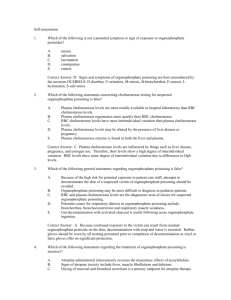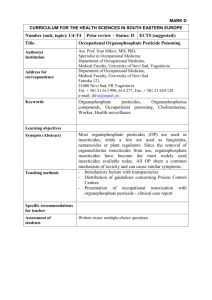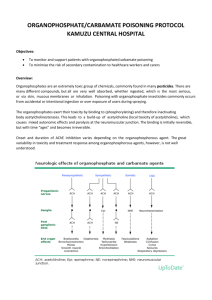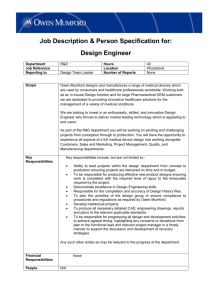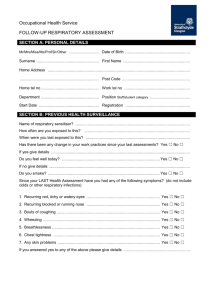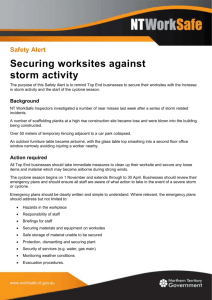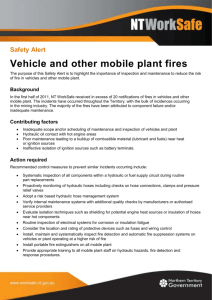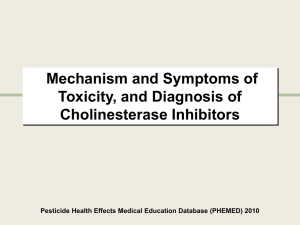Organophosphate Health Surveillance Form
advertisement
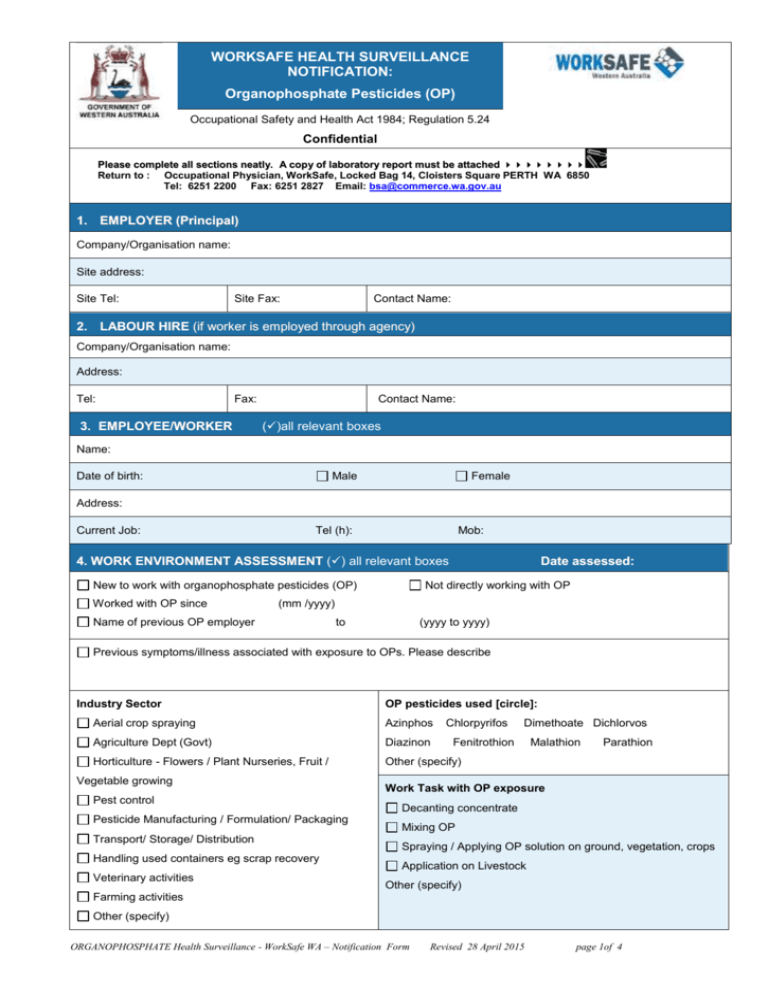
WORKSAFE HEALTH SURVEILLANCE NOTIFICATION: Organophosphate Pesticides (OP) Occupational Safety and Health Act 1984; Regulation 5.24 Confidential Please complete all sections neatly. A cop y of laboratory report must be attached Return to : Occupational Physician, WorkSafe, Locked Bag 14, Cloisters Square PERTH WA 6850 Tel: 6251 2200 Fax: 6251 2827 Email: bsa@commerce.wa.gov.au 1. EMPLOYER (Principal) Company/Organisation name: Site address: Site Tel: Site Fax: Contact Name: 2. LABOUR HIRE (if worker is employed through agency) Company/Organisation name: Address: Tel: Fax: 3. EMPLOYEE/WORKER Contact Name: ()all relevant boxes Name: Date of birth: Male Female Address: Current Job: Tel (h): Mob: 4. WORK ENVIRONMENT ASSESSMENT () all relevant boxes New to work with organophosphate pesticides (OP) Worked with OP since Date assessed: Not directly working with OP (mm /yyyy) Name of previous OP employer to (yyyy to yyyy) Previous symptoms/illness associated with exposure to OPs. Please describe Industry Sector OP pesticides used [circle]: Aerial crop spraying Azinphos Agriculture Dept (Govt) Diazinon Horticulture - Flowers / Plant Nurseries, Fruit / Other (specify) Vegetable growing Pest control Pesticide Manufacturing / Formulation/ Packaging Transport/ Storage/ Distribution Handling used containers eg scrap recovery Veterinary activities Chlorpyrifos Dimethoate Dichlorvos Fenitrothion Malathion Parathion Work Task with OP exposure Decanting concentrate Mixing OP Spraying / Applying OP solution on ground, vegetation, crops Application on Livestock Other (specify) Farming activities Other (specify) ORGANOPHOSPHATE Health Surveillance - WorkSafe WA – Notification Form Revised 28 April 2015 page 1of 4 Pattern of OP exposure [during active OP work period] Frequent /Seasonal Regular Daily (>5 days in a work week) Occasional 2-3 days in a work week 2-3 days in a work month Infrequent Seasonal 1 day or less in a work month Several days per week for a season Duration of OP exposure Long Short > 6-8 hrs in a day Brief 2-4 hrs in a day Minimal < 1 hr in a day describe () only one box Current Exposure Pattern (AMP to complete) Baseline Very occasional use Intermittent use Seasonal use Regular daily use Post-accidental exposure e.g. spill 5. PERSONAL CONTROLS () all relevant boxes Smoker Ex- Smoker Non-Smoker Clean shaven Yes No Shower & change into clean clothes at end of shift Yes No Wash hands/ face before eating or drinking Yes No Yes No Trained in organophosphate processes and procedures 6. WORKPLACE CONTROLS() all relevant boxes Wear protective gloves Yes No Laundering by employer Yes No Respirator use Yes No Wash basins & showers Yes No Eye protection Yes No Smoking or Eating in workshop Yes No Overalls/ Work Clothing Yes No Local exhaust ventilation Yes No Respirator use Yes No Respirator type: Other – describe Comments: ORGANOPHOSPHATE Health Surveillance - WorkSafe WA – Notification Form Revised 28 April 2015 page 2of 4 7. BIOLOGICAL MONITORING Use either (A) or (B) methods (Ref: Guide- Hazardous chemicals requiring health monitoring. SafeWork Australia, March 2013) A) Blood Cholinesterase test (Ellman method) Test Date RBC Cholinesterase (kU/L) Plasma Cholinesterase (kU/L) Timing Comment % fall in cholinesterase Baseline 1 (B1) pre-exposure Test - when exposure-free for 4 weeks Baseline 2 (B2) pre-exposure Re-Test 3-14 days later –again exposure-free Baseline 3 (B3) pre-exposure Re-Test only if (B1)-(B2) exceeds 20% Average of Baseline results (B4) Compare test results to BASELINE RESULTS Pre-shift Post-shift Pre-shift Post-shift Pre-shift Post-shift Note: A pre-exposure Baseline level (B4) is essential for comparison with exposure test results. 1. Baseline - ideally 2 pre-exposure tests should be performed at least 3 days apart, or no sooner than 30 days after prior exposure. Reliability is indicated by the two tests being within 10% of each other. 2. Periodic testing should occur during period of OP use (latter half of work day) 3. > 20% fall in cholinesterase – Re-test 4. > 40% fall in cholinesterase – Remove from exposure till returns to baseline level. Employer to review controls. Reference: Safe Work Australia, Isocyanates, Hazardous Chemicals Requiring Health Monitoring, March 2013 B) DISCRETIONARY TEST- Urinary metabolite test (dialkyl phosphate (DAP) metabolites Test Date Urinary DAP metabolites (μ/mol creatinine) Timing Comment () one box Pre-shift Post-shift Next day after OP use Pre-shift Post-shift Next day after OP use Pre-shift Post-shift Next day after OP use 1. <100 μ/mol creatinine - considered “low occupational exposure” 2. 100-1000 μ/mol creatinine - indicates occupational exposure; employer to review controls to reduce exposure levels. 3. >1000 μ/mol creatinine - indicates high occupational exposure; may be associated with a fall in blood cholinesterase levels. Employer to review controls. Ref: Chemical analysis branch handbook. Testsafe Australia, Workcover NSW, 2009 ORGANOPHOSPHATE Health Surveillance - WorkSafe WA – Notification Form Revised 28 April 2015 page 3of 4 8. RISK ASSESSMENT (Appointed Medical Practitioner to complete) Abnormal symptoms or clinical findings related to organophosphate exposure? Yes No Comment (include any health & safety concerns, clinical symptoms and signs, health advice provided etc) : 9. RECOMMENDATIONS (by Appointed Medical Practitioner) () all relevant boxes Health Surveillance review was completed on: Comments Suitable for work with organophosphate pesticides Counselled Employee. Informed Employer to review and implement controls in workplace. Repeat test in weeks / months Removal from exposure to organophosphate Medical examination by Medical Practitioner on / Fit to resume work with organophosphate from / / Referral for further tests (Specify) Referral to: Occupational Physician Respiratory Physician Physician (specify) Additional Comments APPOINTED MEDICAL PRACTITIONER (responsible for supervising health surveillance) Name: Dr Signature: Date: Address: Tel: Fax: Contact person: Email: For information or assistance, contact: Occupational Physician or Occupational Health Nurse, WorkSafe : 6251 2200 ORGANOPHOSPHATE Health Surveillance - WorkSafe WA – Notification Form Revised 28 April 2015 page 4of 4 /
